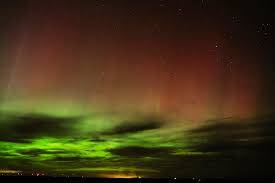**Aurora Alert: Powerful Geomagnetic Storm Could Spark Northern Lights as Far South as Illinois Tonight and Tomorrow**
Stargazers and aurora enthusiasts across the United States are in for a treat as a powerful geomagnetic storm is set to illuminate the skies with the northern lights. According to space weather experts, a coronal mass ejection (CME) from the Sun has caused an intense geomagnetic storm, which could bring the aurora borealis further south than usual, potentially reaching states like Illinois and other regions unaccustomed to such celestial displays.
This rare opportunity is expected to occur tonight and tomorrow, with forecasts indicating that the geomagnetic activity could produce vibrant and colorful displays of light, painting the skies in hues of green, purple, pink, and red.
### **What Causes the Northern Lights?**
The northern lights, or aurora borealis, occur when charged particles from the Sun collide with the Earth's atmosphere. These particles, carried by the solar wind, interact with gases such as oxygen and nitrogen in the atmosphere, resulting in the vibrant light displays that dance across the polar regions.
Normally, the auroras are visible in high-latitude areas such as Alaska, Canada, and Scandinavia. However, during strong geomagnetic storms like the one currently unfolding, the auroral oval expands, allowing the lights to be seen much further south.
### **Details of the Geomagnetic Storm**
The National Oceanic and Atmospheric Administration's (NOAA) Space Weather Prediction Center (SWPC) has issued a geomagnetic storm warning at the G3 (strong) level, with potential to reach G4 (severe). This storm is driven by a powerful CME that erupted from the Sun’s surface a few days ago, sending a massive wave of solar plasma hurtling toward Earth.
As the CME interacts with the Earth’s magnetic field, it creates disturbances that intensify auroral activity. The current storm is expected to peak tonight and continue into tomorrow, offering a two-night window for aurora sightings across much of the United States.
### **Where and When to See the Northern Lights**
Residents as far south as Illinois, Iowa, Indiana, and even northern parts of Kansas and Kentucky may have the chance to witness the northern lights. For those in traditionally aurora-rich areas like the northern Midwest, New England, and the Pacific Northwest, the lights should be especially vibrant and widespread.
The best times to view the aurora will be during the darkest hours of the night, typically between 10 PM and 2 AM local time. To maximize your chances of spotting the northern lights, follow these tips:
- **Find a Dark Location:** Avoid city lights and head to rural areas with minimal light pollution.
- **Check the Skies:** Clear skies are essential for aurora viewing, so monitor local weather forecasts.
- **Look North:** In areas further south, the aurora will appear closer to the horizon, so find an unobstructed northern view.
- **Be Patient:** Auroral activity can vary in intensity, so give yourself plenty of time to watch.
### **Tools to Track the Aurora**
To improve your chances of catching the northern lights, use resources and apps designed to track auroral activity. Websites like SpaceWeather.com and NOAA's SWPC offer real-time updates on geomagnetic activity. Popular apps like Aurora Forecast and My Aurora Forecast provide alerts and visibility predictions based on your location.
Social media platforms are also great for sharing real-time sightings. Search hashtags like #NorthernLights or #AuroraBorealis to see where the lights are visible in your region.
### **Safety Precautions**
While the geomagnetic storm creates a mesmerizing natural spectacle, it can also have implications for technology and infrastructure. Strong storms like this one can disrupt satellite operations, GPS systems, and even power grids in extreme cases. Airlines flying polar routes have been advised to adjust flight paths to minimize exposure to heightened radiation levels.
Fortunately, these impacts are unlikely to affect individuals observing the auroras from the ground. However, those using GPS-based devices or satellite communications should be aware of potential disruptions.
### **Auroras in History and Culture**
The northern lights have captivated humanity for centuries, inspiring myths, folklore, and scientific curiosity. Indigenous cultures in the Arctic regions, such as the Sámi of Scandinavia and the Inuit of Canada, have long revered the auroras, associating them with spirits or messages from ancestors.
Today, the auroras continue to fascinate scientists and laypeople alike, serving as a reminder of the dynamic relationship between the Sun and Earth. The current storm highlights the power of solar activity and its ability to create awe-inspiring natural phenomena visible even in unexpected places.
### **A Rare Opportunity**
Aurora sightings as far south as Illinois are a rare occurrence, making this geomagnetic storm a must-see event for anyone in the affected areas. Even if you’re outside the predicted visibility zone, it’s worth stepping outside tonight or tomorrow to scan the skies—you might catch a glimpse of the celestial display.
For those lucky enough to witness the northern lights, the experience is unforgettable. The shimmering colors and ethereal movements of the aurora borealis are a reminder of the beauty and complexity of our universe.
So, grab a warm coat, head to a dark spot, and look up. The northern lights may just make an appearance in your area, offering a spectacular show that connects us to the vastness of space and the Sun’s ever-present influence on our planet.


